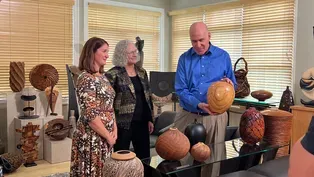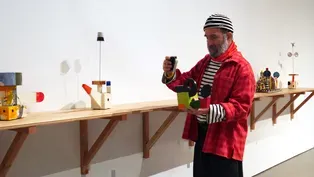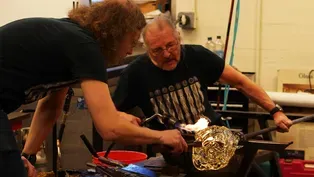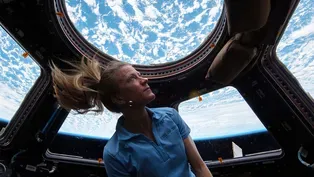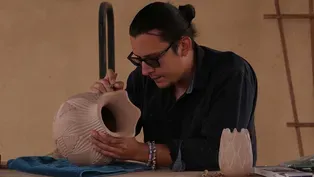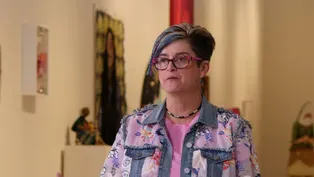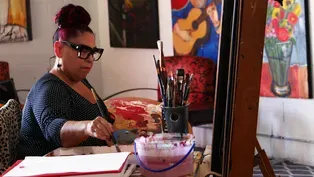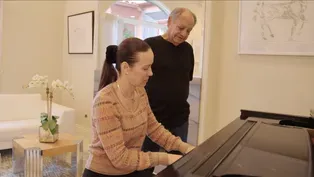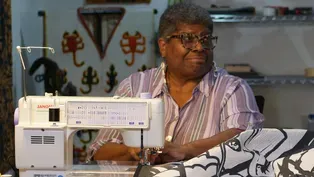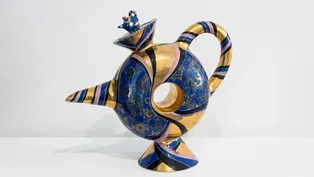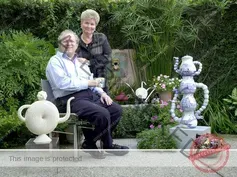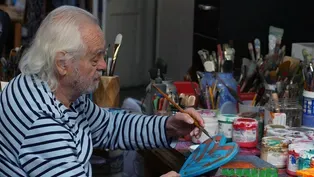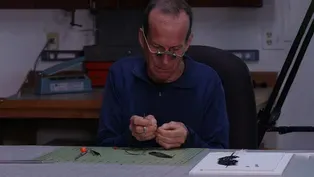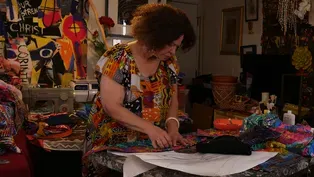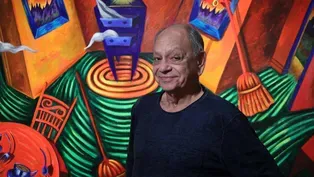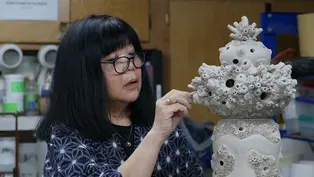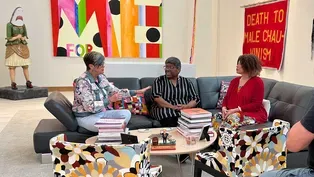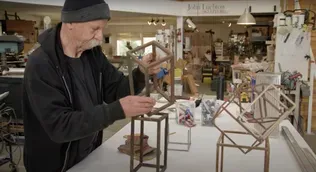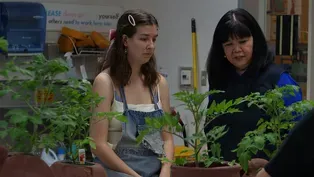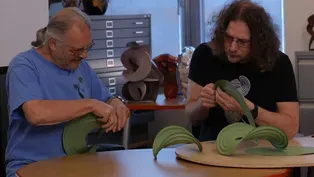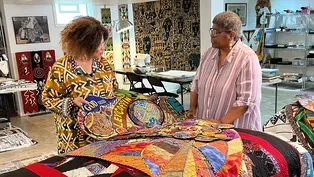
Artist John Luebtow segment
Clip: Season 16 | 10m 55sVideo has Closed Captions
Glass sculptor John Luebtow creates monumental glass and steel installations.
John Luebtow is a glass sculptor and teacher. He introduces us to the founder of the modern kindergarten, Friedrich Froebel, and how Froebel’s geometric “gifts” inspired John and generations of other artists. Segment from SCIENCE episode
Problems with Closed Captions? Closed Captioning Feedback
Problems with Closed Captions? Closed Captioning Feedback

Artist John Luebtow segment
Clip: Season 16 | 10m 55sVideo has Closed Captions
John Luebtow is a glass sculptor and teacher. He introduces us to the founder of the modern kindergarten, Friedrich Froebel, and how Froebel’s geometric “gifts” inspired John and generations of other artists. Segment from SCIENCE episode
Problems with Closed Captions? Closed Captioning Feedback
How to Watch Craft in America
Craft in America is available to stream on pbs.org and the free PBS App, available on iPhone, Apple TV, Android TV, Android smartphones, Amazon Fire TV, Amazon Fire Tablet, Roku, Samsung Smart TV, and Vizio.
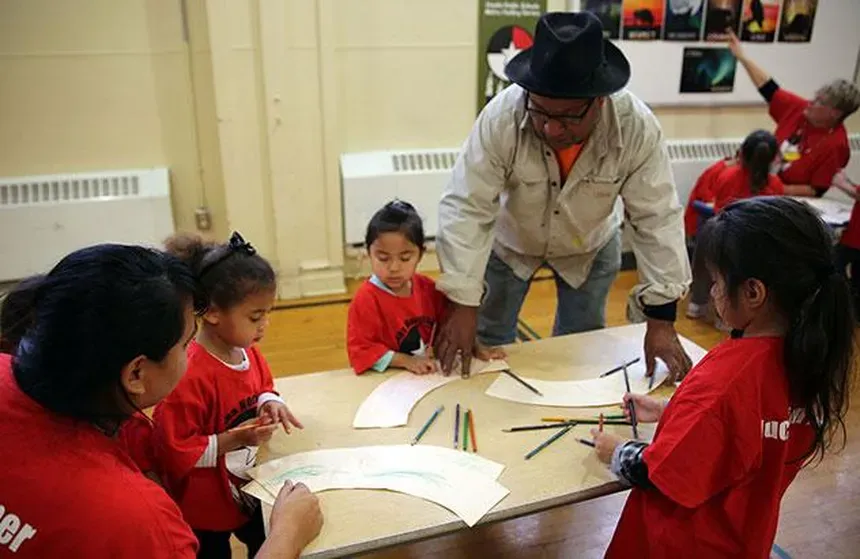
Education Guides
Download Craft in America education guides that educate, involve, and inform students about how craft plays a role in their lives, with connections to American history and culture, philosophies and science, social causes and social action.Providing Support for PBS.org
Learn Moreabout PBS online sponsorshipCome on in, come on in.
Come on.
For me, everything starts with the pencil.
The pencil is the application of the thought to the paper.
So you start just fooling around with a direction.
And once you see the direction, you begin to see that this could work in this space.
Then the idea begins to develop to be able to be functional and built.
I'm dealing with a glass, steel, water, and light.
So all of the senses can be experienced: seeing, hearing, touching, smelling.
There's never a boring moment.
That's the beauty of being an artist.
I've got a lot of different ideas going all the time.
I'll be working on something for 40 minutes and then I go to something else.
It's just my nature.
John is like an overgrown eight year old.
It's either full speed ahead or stop.
Nothing in between.
I remember my first week in kindergarten we did drawing, we did cutting things out.
We were just having fun as kids.
Friedrich Fröbel was the inventor of kindergarten.
In the '70s and '80s, I spent time studying his work.
Fröbel was born in Germany.
His father was a Lutheran minister.
In university, he studied botany, mathematics and he was an apprentice of Samuel Weiss at the Museum of Crystallography.
Samuel Weiss was one of the discoverers of how crystalline structure develops.
The drawings of Samuel Weiss show how the cube grew to the other crystalline forms.
After having an education in sciences, Fröbel worked as a teacher.
That changed the rest of his life.
You know, as a little kid, I wanted to be an architect.
But in college, architecture was mathematics so I got into majoring in art.
I started working in clay.
I loved the feeling of the, you know how you could manipulate it.
So I got a master's in ceramics.
And then that's when I went to Europe.
I was working with the Queens Royal Blue Delft Company.
They established a factory in Delft in 1653.
We built ceramic murals, some that were 50-by-150 feet.
In the Netherlands, I also worked with Leerdam Glass.
I saw transparency, translucency and all those qualities of glass that everything else in the sculptural world did not have.
I was kind of wooed into that glass world and I said, I gotta do this.
The educational system pre-1800 was rote learning strict discipline.
The teachers were dictators.
And then, Fröbel published his philosophy in 1826.
For him, the kinder is the child.
The garden is for planting things and growing.
So within the mind of the child, that seed would grow.
And he helped nurture that growth with his kindergarten teaching system, which is based on the crystalline structure concept from Samuel Weiss.
Cube, cylinder, and the sphere.
By spinning this cube, it becomes a cylinder.
And this one, when you spin this cylinder, it becomes a sphere.
Fröbel began to break it down into its elements.
The solid cube becomes a fragmented cube.
The children begin to arrange it in the different ideas.
So this is the gift of knowledge.
Like mathematics, halves, quarters the gift of beauty is to take the shapes and to arrange them into any kind of a pattern and the gift of life, the children create buildings out of blocks, chairs out of blocks.
After the block system, they play with parquetries, paper cutting, paper folding, peas and sticks.
So Fröbel was presenting objects for the children to learn through sense perception experiential contact with the world.
When I got back to America, I didn't have a job but I found a teaching position in L.A. and I liked it because it was fun.
My approach to teaching is actually Fröbel derivative because it deals with opening up freedom of expression and freedom of feelings, but in order to express that freedom, you have to have the techniques.
And I always felt that you must understand your media in order to create anything.
I made a series of small blown forms.
I played with this idea.
I thought, that's kind of cool, that's fun.
But once I took this apart and I looked at this form, I saw it standing 10 feet tall.
Now in order to make that ten feet tall, you have to have furnaces that are big enough to be able to put the glass in to bend it.
So I built a walk-in kiln.
You start with a flat piece of glass and you put it into the kiln, suspend it over the mold.
We used steel pipes.
We run that up to a temperature of about 1100 degrees, 14 to 16 hours, to get to the bending point.
Then the cooling takes three to four days.
Once those pieces are bent in the large kiln, then we transfer those to the taping table.
He does all that taping single handedly, freehand, and they're perfect.
From the taping process, I wheel them into the sandblast booth.
Once the piece is sandblasted, the surface is etched, then we bring it in the studio, remove all the tape.
So the pattern then is finished.
In 1817, Fröbel built a school in Keilhau.
And then in 1837, kindergarten in Bad Blankenburg, which is over the hill, and he would hike back and forth.
It's about nine miles.
From there, Fröbel's system spread around Germany and then around the world: England, Japan, Russia, the USA.
Can you open the door and put your finger in?
I opened it.
What can we do with these blocks?
The Fröbel system was kind of lost in the mid-20th century.
But it's really coming back.
Fröbel USA is trying to get this into the kindergarten system today.
I made a rocket ship.
I made a square rocket ship.
Three, two, one, blast off.
It's the rebirth of freedom in education.
Now, this is controversial, but Fröbel's kindergarten is the origin of modern abstract art.
Children learning that system became 20th century painters, sculptors, designers.
Frank Lloyd Wright wrote, in 1876 my mother went to the Philadelphia World's Fair and saw the presentation of the kindergarten system.
And he says, when my mother introduced these blocks to me, they changed the way I saw the world.
Piet Mondrian began as a teacher.
So he knew the Fröbel system.
I think that he integrated that totally into his work.
Another perfect example is Buckminster Fuller.
He said, I discovered my geometric structures, my geodesic domes from Fröbel's peas and sticks.
Goldi and I went to Germany in 2019.
We went to his birthplace.
We went to where his schools were.
John's got Fröbel on the brain.
So, we tracked the Fröbel trail and went up the hill.
And on the top is a monument to him the cube, the cylinder, and the sphere.
10 feet tall, almost.
I'm getting goose pimples now because it was just something, this really exists.
Go ahead, go ahead, you're up, we got it, we got it, go up.
Perfect, perfect, perfect.
I learned so much about life from Fröbel.
His ideas connected me to a whole new world.
A visual world.
Wood objects in Fleur, Judy and Jeff's collections
Video has Closed Captions
See more objects in Fleur Bresler's and Judith Chernoff and Jeffrey Bernstein's collections (4m 14s)
Video has Closed Captions
Learn more about Peter Shire's art and career. Bonus video from COLLECTORS episode (6m 29s)
See more of Erik and Martin Demaine's sculptures
Video has Closed Captions
Father-son team make unique curved-crease origami sculptures and incorporate it with glass (4m 47s)
Video has Closed Captions
Joseph & Sergio Youngblood Lugo on bear paw symbols in Santa Clara Pueblo pottery (2m 3s)
Quilt artist Karen Nyberg segment
Video has Closed Captions
Former NASA astronaut and quilter Karen Nyberg continues to create art inspired by space and science (6m 35s)
Potters Joseph & Sergio Youngblood Lugo segment
Video has Closed Captions
Santa Clara Pueblo potters Joseph & Sergio Youngblood Lugo use ancestral techniques in their work (9m 5s)
Objects in Sara Vance Waddell's collection
Video has Closed Captions
Sara Vance Waddell on how she became a collector and shows us pieces in her collection. (5m 15s)
Meet the artists in Cheech Marin's Chicano Art collection
Video has Closed Captions
Learn more about Jaime "Germs" Zacarias, Yolanda González, and Francisco Palomares (8m 42s)
Video has Closed Captions
Pianist Natasha Marin on living with Chicano Art (1m 8s)
Learn more about the Women of Color Quilters Network
Video has Closed Captions
Learn more about Carolyn Mazloomi and the Women of Color Quilters Network (6m 38s)
Joan Takayama-Ogawa's ceramic history
Video has Closed Captions
Artist Joan Takayama-Ogawa on her mentor, Ralph Bacerra and Joan's family history in ceramics (5m 4s)
Gloria & Sonny Kamm and Peter Shire segment
Video has Closed Captions
Meet teapot collectors Sonny and Gloria Kamm and artist Peter Shire in Los Angeles. (9m 32s)
Video has Closed Captions
Chicano artist Frank Romero on his career. Bonus video from COLLECTORS episode (7m 4s)
Fleur Bresler, Judith Chernoff, Jeffrey Bernstein, Norm Sartorius segment
Video has Closed Captions
Meet three collectors Fleur Bresler, Judith Chernoff & Jeffrey Bernstein and sculptor Norm Sartorius (13m 14s)
Feather artist Chris Maynard segment
Video has Closed Captions
Chris Maynard creates intricate art from bird feathers, inspired by his love of the natural world (7m 29s)
Video has Closed Captions
This father-son team takes inspiration from their research to create curved-crease paper sculptures (10m 56s)
Cynthia Lockhart on her career
Video has Closed Captions
Fiber artist Cynthia Lockhart on her careers and how her work ended up in the Renwick's collection (6m 19s)
Cheech Marin & Chicano Art segment
Video has Closed Captions
Comedian and collector Cheech Marin introduces us to his Chicano Art collection and artists (16m 51s)
Ceramic artist Joan Takayama-Ogawa segment
Video has Closed Captions
Ceramic artist Joan Takayama-Ogawa uses her work in clay to respond to the ongoing climate emergency (8m 38s)
Carolyn Mazloomi, Cynthia Lockhart, Sara Vance Waddell segment
Video has Closed Captions
Meet artist & collector Carolyn Mazloomi, artist Cynthia Lockhart, and collector Sara Vance Waddell (10m 38s)
Astronaut turns space photographs into quilts
Video has Closed Captions
Learn about retired NASA astronaut and quilter Karen Nyberg's space textiles (2m 6s)
Video has Closed Captions
Glass sculptor John Luebtow creates monumental glass and steel installations. (10m 55s)
Artist explores the climate crisis
Video has Closed Captions
Sustainability at Otis and Joan's climate change course (2m 33s)
American Craft Council marketplace segment
Video has Closed Captions
Meet dynamic young collectors and the artists they support at American Craft Made Baltimore (3m 47s)
Video has Closed Captions
SCIENCE investigates the unexpected intersection between art and the sciences (1m)
Video has Closed Captions
COLLECTORS reveals the essential role that craft appreciators play in the community. (58s)
Providing Support for PBS.org
Learn Moreabout PBS online sponsorship